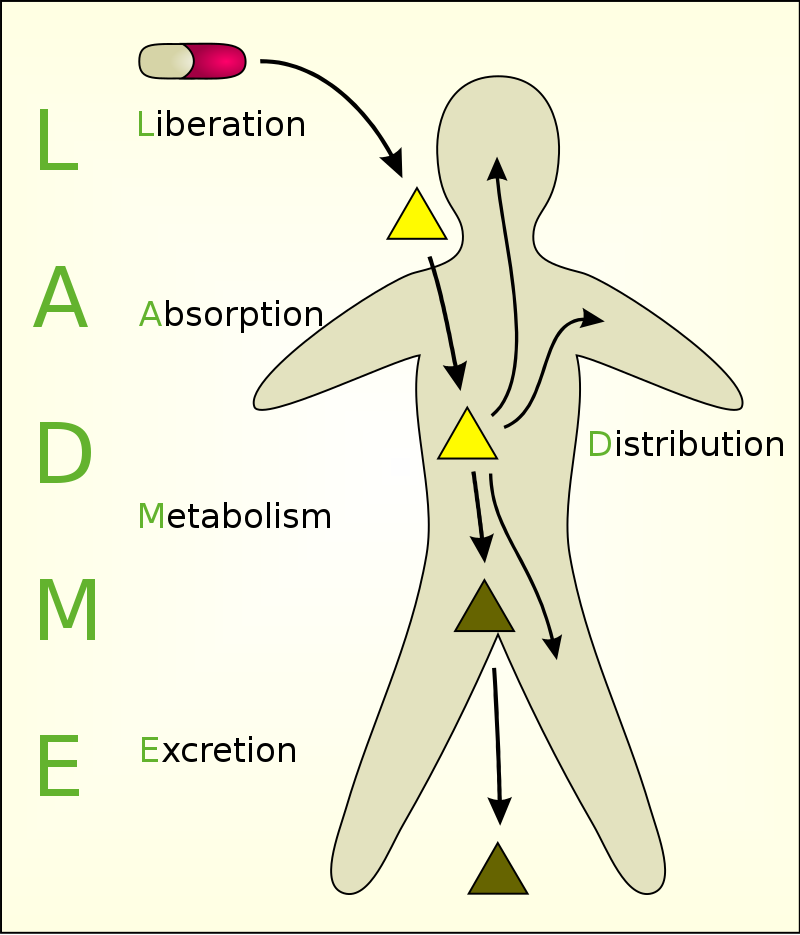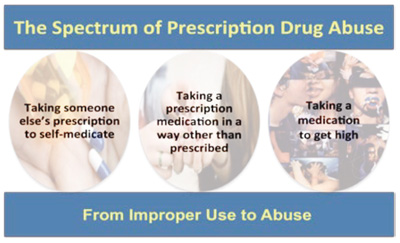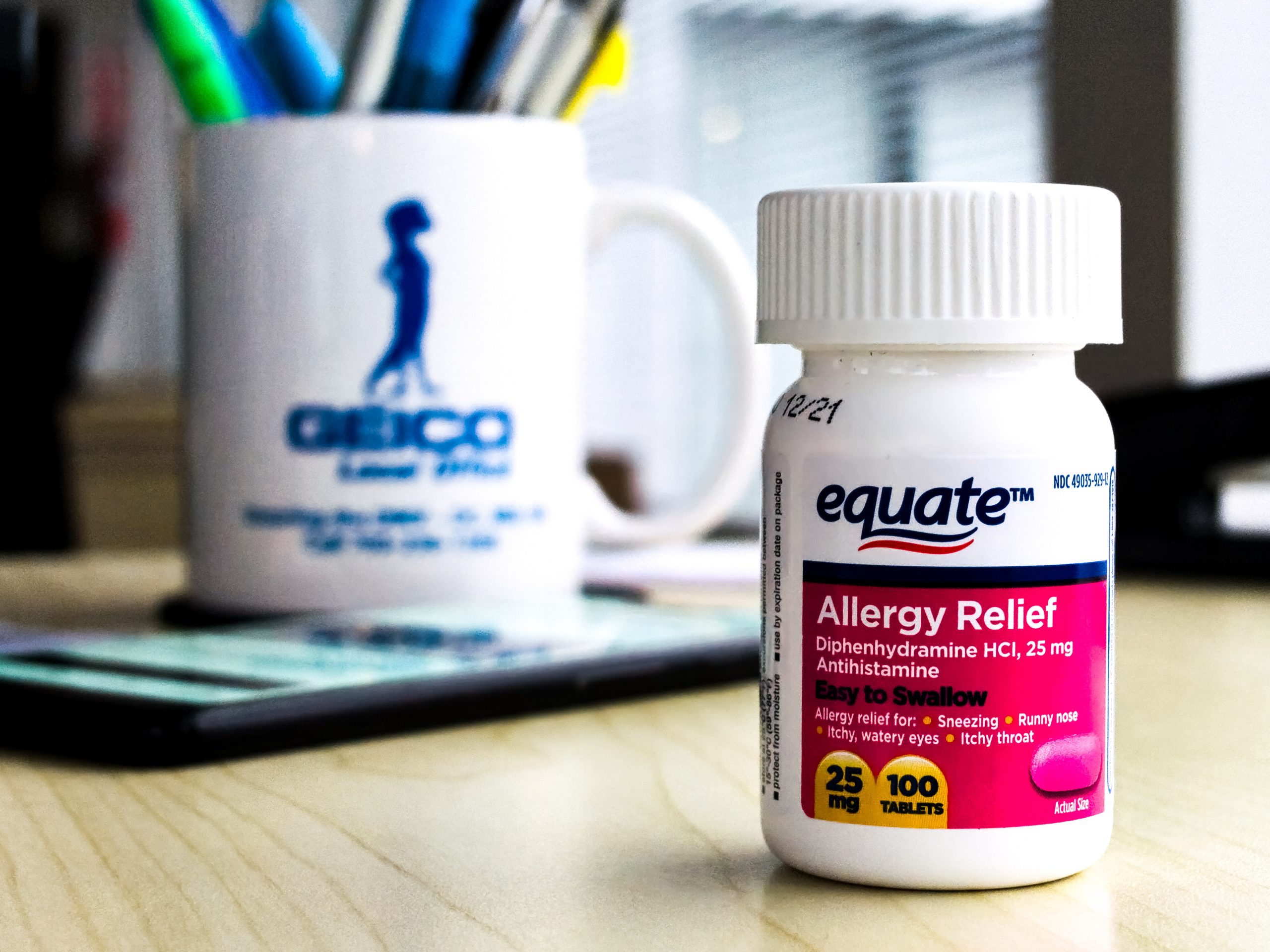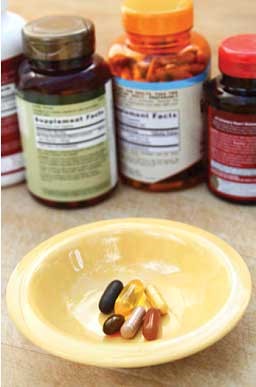7 Prescription Medication, Over-the-Counter Drugs, Dietary Supplements, and Appearance and Performance Enhancers
Introduction
Fifty-seven percent of American adults use dietary supplements.
Forty-seven percent of American adults have used a prescription drug in the last 30 days.
Five percent of American adults have used appearance and performance enhancers, most specifically steroids.
These kinds of drugs are often thought of as safe. When prescribed and taken under the guidance of a medical provider or pharmacist, over-the-counter (OTC) and prescription drugs are used to successfully cure, prevent, or treat a variety of diseases and illnesses. You might take these drugs because you need help with aches, pains, muscle concerns, or dietary issues, or to perform better in sports or in school. You may have also been introduced to many of these drugs because friends or others have used them with success. But even these drugs can be misused and cause harm to the individual. Many OTC and prescription drugs interact with other medicines, can cause an allergic reaction, or can be misused and lead to addiction and death (MedlinePlus, Drug reactions, 2021). According to the Centers for Disease Control and Prevention (2021), overdose deaths involving prescription opioids more than quadrupled from 1999 to 2019. Similarly to prescription drugs, some OTC medicines have active ingredients with the potential for misuse at higher-than-recommended dosages. It is important to understand that any use of drugs can be unsafe and that there are risks with taking all drugs, even ones you might think are safe.
Learning Objectives
- Understand what prescription medications are, how they should be obtained, and how they should be used.
- Understand what OTC drugs are and how they are used.
- Understand what performance enhancers are and be familiar with the concerns with their use.
- Understand what dietary supplements are and how they are used.
- Describe the legal differences between drugs and dietary supplements.
- Explain the concepts behind the terms GRAS, GRAE, SAFE, and GRAHL.
- Explain the difference between prescription medications, OTC drugs, dietary supplements, and performance enhancers.
Image 7.1 – Pharmacist with Prescription Medications

Learning Content
Prescription Medications
Watch this short video from Mayo Clinic Radio titled “Cost of prescription drugs” on prescription drugs and the costs associated with using them:
Video 7.1 – Cost of Prescription Drugs
History and Background
In 1938 prescription drugs were required to be approved for use.
Forms of Prescription Medication and How it is Consumed
A prescription drug product requires authorization (e.g., often in the form of a written order known as a prescription) by a licensed practitioner (e.g., a medical doctor) before that drug product may be dispensed or given to a patient.
Here is the definition of a prescription drug: a drug that is intended for use by man and, which because of its toxicity or other potentiality for harmful effect, or the method of its use, or the collateral measures necessary to its use, is not safe for use except under the supervision of a practitioner licensed by law to administer such drug; or it is one that is limited by an FDA-approved application for use only under the professional supervision of a practitioner licensed by law to administer such drug.
All drugs must have labeling that bears “adequate directions for use.” Prescription drugs, however, by definition, require the intervention of a licensed healthcare professional. A prescription drug product requires authorization by a licensed practitioner before that drug product may be dispensed or given to a patient.
Prescription Medications’ Effects on the Body
Pharmacokinetics is the study of how drugs move through the body after administration.
A number of phases occur once the drug enters into contact with the organism, these are described using the acronym LADME:
- Liberation of the active substance from the delivery system; Liberation is the first step in the phase that allows medication to enter the body and liberate the active ingredient
- Absorption of the active substance by the organism
- Distribution through the blood plasma and different body tissues
- Metabolism, sometimes called xenobiotic metabolism, is the process of transforming substances so that can be excreted more easily from the body
- Excretion or elimination of the substance or the products of its metabolism
Infographic 7.1 – Infographic Depicting LADME Acronym

Key terms related to how prescription drugs work in the body
- Dose: Amount of drug administered
- Dosing interval: Time between drug dose administrations
- Volume of distribution: The apparent volume in which a drug is distributed (i.e., the parameter relating drug concentration in plasma to drug amount in the body)
- Concentration: Amount of drug in a given volume of plasma
- Absorption half-life: The time required for 50% of a given dose of drug to be absorbed into the systemic circulation
- Absorption rate constant: The rate at which a drug enters into the body for oral and other extravascular routes
- Elimination half-life: The time required for the concentration of the drug to reach half of its original value
- Elimination rate constant: The rate at which a drug is removed from the body
The Food and Drug Administration (FDA) is a federal agency of the U.S. Department of Health and Human Services. Visit the FDA website to review regulation information. The FDA is responsible for protecting and promoting public health through the control and safety of prescription medications (and many other drugs and medical devices).
Many people make the mistake of thinking that all prescription medications are safe. While prescription medications are highly regulated, these substances still come with many dangers when misused or inappropriately combined with other drugs or substances. In order to ensure safe use of prescription medications:
- Make sure you are getting the right medication. Make sure your doctor clearly understands your condition and the signs and symptoms you are experiencing. Tell your doctor about all of your prescriptions, as well as any OTC medications, herbals and supplements, and alcohol, and other drugs you are using. Ask your doctor whether there is an alternative medication with ingredients that have less potential for addiction.
- Check in with your doctor. Talk with your doctor on a regular basis to make sure that the medication you are taking is working and that you are taking the right dose.
- Follow directions carefully. Use your medication the way it was prescribed. Do not stop or change the dose of a drug on your own if it does not seem to be working. For example, if you are taking a pain medication that is not adequately controlling your pain, do not take more without first consulting with your doctor or prescribing pharmacist.
- Know what your medication does. Ask your doctor or pharmacist about the effects of your medication, so you know what to expect. Also check if other drugs, OTC products, or alcohol should be avoided when taking this medication.
- Never use another person’s prescription. Everyone is different. Even if you have a similar medical condition to that of another person, their medication may not be the right medication for you.
- Do not order prescriptions online unless they are from a trustworthy pharmacy. Some websites sell counterfeit prescription and nonprescription drugs that could be dangerous.
Watch the below video to learn more about the dangers of mixing drugs.
Video 7.2 – The Dangers of Mixing Drugs
Check Your Knowledge
Use, Misuse, and Overuse
Most of the time, medicines make our lives better. Medications reduce aches and pains, fight infections, and control problems such as high blood pressure or diabetes. But medicines can also cause unwanted reactions.
One problem that may occur when taking medications is possible interactions with other substances, which may occur between
- two drugs, such as aspirin and blood thinners;
- drugs and food, such as statins and grapefruit;
- drugs and supplements, such as ginkgo and blood thinners;
- drugs and diseases, such as aspirin and peptic ulcers.
Interactions can change the actions of one or both substances. The drugs might not work, or you could get side effects.
Side effects are unwanted effects caused by the drugs. Most side effects are mild, such as a stomach aches or drowsiness, and go away after you stop taking the drug. Others can be more serious.
Drug allergies are another type of reaction. They can be mild or life-threatening. Skin reactions, such as hives and rashes, are the most common type of drug reaction. Anaphylaxis, a serious allergic reaction, is more rare.
When you start a new prescription or OTC medication, make sure you understand how to take it correctly. Know the other medications and foods you need to avoid. Ask your health care provider or pharmacist if you have questions (MedlinePlus Drug reactions, 2021).
Infographic 7.2 – How Prescription Medications are Misused

Prescription medications can be misused by:
- taking someone else’s prescription medication, even if it is for a medical reason (such as to relieve pain, to stay awake, or to fall asleep)
- taking a prescription medication in a way other than prescribed—for instance, taking more than the prescribed dose or taking it more often, or crushing pills into powder to snort or inject the drug
- taking the prescription medication to get “high”
- mixing it with alcohol or certain other drugs. Your pharmacist can tell you what other drugs are safe to use with specific prescription drugs (NIDA, Over-the-counter medicines, 2021).
Critical Thinking
Have you ever had a reaction using a prescription drug? Have you ever misused prescription drugs?
Lifespan Considerations
Infants, School Age Children, Teens
Children of all ages metabolize medications differently. Many medications for children are based on weight. It is important to understand dosing and ensure that children are taking the correct doses when using prescriptions.
Older Adults
As baby boomers age they experience, like most older adults, a greater frequency of illness and disease. Among the older baby boomer generation, there is a greater demand for prescription drugs, especially pain medications.
The primary risk with aging adults is addiction with use of long-term prescription medications, especially opioids. It is important to take prescriptions under the advice of a medical care provider and to consistently use the same pharmacist so that they can monitor prescriptions you have as well as check for interactions with drugs you may be getting from various doctors.
Older adults are more likely to experience polypharmacy. Polypharmacy is used to describe the use of multiple medications at one time. Many aging individuals are taking 5 to 11 medications at one time for various diseases, ailments, and health concerns. It can be hard at times to keep track of the drugs being taken, leading to risk with overdose and possible death.
Image 7.2 – Equate Allergy Relief Pills in Container

Check Your Knowledge
Over-the-Counter Drugs
What exactly is an OTC drug?
There are hundreds of OTC drugs at your local pharmacy. Many items like cosmetics, dietary supplements, or other medical devices, which have their own regulatory requirements, may also be classified as “drugs.”
The term “drug” is a legal one. As described in the Federal Food, Drug, and Cosmetic Act: a drug is an article intended for use in the diagnosis, cure, mitigation, treatment, or prevention of disease and/or an article (other than food) intended to affect the structure or function of the human body and/or an article intended for use as a component of such an article. The intended use of a product is very important in determining how a product is regulated.
History and Background
From 1938 to 1962, several thousand prescription and OTC drugs were introduced into the marketplace. In 1972 OTC drugs were required to be proven safe and effective for use. In 1972 the National Research Council conducted a study of these drugs and evaluated them based on their active ingredients. The drugs were then put into one of three categories:
Table 7.1 – OTC Drug Categories
| Drug Category | Category Description |
| Category I | drugs determined to be safe, effective, and properly labeled |
| Category II | drugs not generally recognized as safe and effective, or recognized as mislabeled |
| Category III | drugs lacking sufficient data to generally be determined safe and effective |
OTC Drug Terms You Should Know:
An OTC drug is considered safe and effective for use by the general public without a prescriber’s authorization (HealthCare.gov, n. d.).
Necessary characteristics for OTC drugs:
- The product has an acceptable safety margin.
- The product has low misuse potential under conditions of widespread availability.
- The drug can be purchased without a prescription.
- The product has adequate labeling.
Forms of OTC Drugs and How they are Consumed
OTC medicines are drugs with a low incidence of misuse that you can buy without a prescription. Some OTC medicines relieve aches, pains, and itches. Some prevent or cure diseases, like tooth decay and athlete’s foot. Others help manage recurring problems, like migraines and allergies (MedlinePlus Over-the-counter medicine, 2017).
OTC drugs are used to treat allergies, pain, headache, fever, cut and burns, digestive and stomach issues, itches, rashes and other skin irritations.
OTC Drug Types and Uses
Table 7.2 – OTC Drug Types and Uses
Critical Thinking
Take some time to look through your medicine cabinet. What over-the-counter medications do you have? Why do you have these medications? Do you understand the risks with using all of the over-the-counter medications you have in your cabinet?
Used, Misuse, and Overuse
OTC medicines that have the potential for misuse include:
- dextromethorphan (DXM), a cough suppressant found in many OTC cold medicines
- loperamide, an anti-diarrheal (NIDA, 2017).
Make sure to follow the instructions on the drug label. If you do not understand the instructions, ask your pharmacist or health care provider (MedlinePlus, Drug reactions, 2021).
Risks with taking OTC drugs:
- The medicine could interact with other medicines, supplements, foods, or drinks you are taking.
- Some medicines should not be used by people with certain medical conditions. For example, people with high blood pressure should not take certain decongestants.
- Some people are allergic to certain medicines.
- Many medicines are not safe during pregnancy. If you are pregnant, check with your health care provider before taking any medicine.
- Be careful when giving medicine to children. Make sure that you give your child the correct dose. If you are giving your child a liquid medicine, do not use a kitchen spoon. Instead use a measuring spoon or a dosing cup marked in teaspoons.
Lifespan Considerations
OTC drugs can be just as addictive as illegal or prescription drugs. The risk of accidental overdose is high, and there can be long-term damage to the brain and body, causing life-threatening or life-changing concerns for the user. Do not take OTC medications without checking with your healthcare provider or pharmacist; be sure to understand all of the risks associated with the use of the drugs.
Image 7.3 – Dietary Pills in Yellow Bowl

Dietary Supplements
Many adults and children in the United States take one or more vitamins or other dietary supplements. In addition to vitamins, dietary supplements can contain minerals, herbs or other botanicals, amino acids, enzymes, and many other ingredients. Dietary supplements are not regulated by the FDA and there are risks with use. Always know what you are putting into your body and make decisions about supplements with advice from your medical care provider (NIH, What you need to know, 2020).
Watch this video on dietary supplements to get a better understanding on what they are and if you should consider taking them.
Video 7.2 – Dietary Supplements: What You Need to Know
Forms of Dietary Supplements and How they are Consumed
Dietary supplements come in a variety of forms, including tablets, capsules, gummies, and powders, as well as drinks and energy bars. Popular supplements include vitamins D and B12; minerals like calcium and iron; herbs such as echinacea and garlic; and products like glucosamine, probiotics, and fish oils.
Some common dietary supplements:
- calcium: to help build bones
- echinacea: to possibly stimulate the immune system to fight colds and other infections
- fish oil: to provide omega 3-fatty acids
- garlic: to improve conditions related to the heart and blood vessels, including high cholesterol and blood pressure
- vitamin D: to promote calcium absorption
- St. John’s Wort: to help depression
- ginkgo: to act as an antioxidant and stimulate blood flow to the brain
- green tea extract: to help with weight loss, blood sugar regulation, disease prevention, and exercise recovery (NIH, What you need to know, 2020).
Dietary Supplements’ Effects on the Body
Some dietary supplements can help provide adequate amounts of essential nutrients if you do not eat a nutritious variety of foods. However, supplements cannot take the place of the variety of foods that are important to a healthy diet.
Some dietary supplements can improve overall health and help manage some health conditions. For example:
- Calcium and vitamin D help keep bones strong and reduce bone loss.
- Folic acid decreases the risk of certain birth defects.
- Omega-3 fatty acids from fish oils might help some people with heart disease.
- A combination of vitamins C and E, zinc, copper, lutein, and zeaxanthin (known as AREDS) may slow down further vision loss in people with age-related macular degeneration (AMD).
Many other supplements need more study to determine if they have value. The U.S. Food and Drug Administration (FDA) does not determine whether dietary supplements are effective before they are marketed (NIH, What you need to know, 2020).
Use, Misuse, and Overuse
Many supplements contain active ingredients that can have strong effects in the body. Always be alert to the possibility of a bad reaction, especially when taking a new product.
You are most likely to have side effects from dietary supplements if you take them at high doses or instead of prescribed medicines, or if you take many different supplements. Some supplements can increase the risk of bleeding or, if taken before surgery, can change your response to anesthesia. Supplements can also interact with some medicines in ways that might cause problems. Here are a few examples:
- Vitamin K can reduce the ability of the blood thinner warfarin to prevent blood from clotting.
- St. John’s Wort can speed the breakdown of many medicines and reduce their effectiveness (including some antidepressants, birth control pills, heart medications, anti-HIV medications, and transplant drugs).
- Antioxidant supplements, such as vitamins C and E, might reduce the effectiveness of some types of cancer chemotherapy.
Manufacturers may add vitamins, minerals, and other supplement ingredients to foods you eat, especially breakfast cereals and beverages. As a result, you may get more of these ingredients than you think, and more might not be better. Taking more than you need costs more and might also raise your risk of side effects. For example, too much vitamin A can cause headaches and liver damage, reduce bone strength, and cause birth defects. Excess iron causes nausea and vomiting, and may damage the liver and other organs.
Be cautious about taking dietary supplements if you are pregnant or nursing. Also, be careful about giving supplements to a child, unless recommended by their healthcare provider. Many supplements have not been well tested for safety in pregnant women, nursing mothers, or children (NIH, What you need to know, 2020).
Lifespan Considerations
Products intended to supplement the diet are not medicines and are not intended to diagnose, treat, mitigate, prevent, or cure diseases. The FDA is the federal agency that oversees both supplements and medicines, but the FDA regulations for dietary supplements are different from those for prescription or over-the-counter medicines.
Here are things you should think about when considering dietary supplement use throughout your lifetime (U. S. Food and Drug Administration What you need to know about dietary supplements. 2017):
- When searching for supplements on the internet, use noncommercial sites (e.g. National Institute of Health or NIH, FDA, U.S. Department of Agriculture or USDA) rather than depending on information from sellers.
- If claims sound too good to be true, they probably are. Be mindful of product claims such as “works better than [a prescription drug],” “totally safe,” or has “no side effects.”
- Be aware that the term “natural” does not always means safe.
- Ask your healthcare provider if the supplement you are considering would be safe and beneficial for you.
- Always remember – safety first!
Image 7.4 – Women Running a Track Race

Appearance and Performance Enhancers
Appearance and performance enhancing drugs (APEDs) are most often used by males to improve looks by building muscle mass or to increase competitiveness in athletic performance. Although APEDs may directly and indirectly have effects on a user’s mood, they do not produce a euphoric high, which makes APEDs distinct from other drugs such as cocaine, heroin, and marijuana. However, users may develop a substance-use disorder, defined as continued use despite adverse consequences. (NIDA, 2021).
History and Background
1935: Testosterone was used in Germany to treat depression.
1954: Professional athletes began misusing anabolic steroids during the 1954 Olympics when Russian weightlifters were given testosterone.
1980: Anabolic steroids started being used by the general population; young men started using anabolic steroids to improve personal appearance and enhance athletic performance.
1991: The Anabolic Steroids Control Act of 1990 places anabolic steroids into Schedule III of the Controlled Substances Act (CSA).
Forms of Appearance and Performance Enhancing Drugs and How they are Consumed
Anabolic steroids are synthetically produced variants of the naturally occurring male hormone testosterone. Both males and females have testosterone produced in their bodies: males in the testes, and females in the ovaries and other tissues. The full name for this class of drugs is androgenic (promoting masculine characteristics) anabolic (tissue building) steroids (the class of drugs). Some of the most misused steroids include Deca-Durabolinâ, Durabolinâ, Equipoiseâ, and Winstrolâ. The common street (slang) names for anabolic steroids include “arnolds,” “gym candy,” “pumpers,” “roids,” “stackers,” “weight trainers,” and “juice” (Drug Enforcement Administration, Diversion Control Division, 2004).
Society’s emphasis on competition could push people into taking drugs to gain an athletic advantage. Society’s emphasis on body image and sex could encourage a person to enhance sexual performance and experiences. These are reasons why appearance and performance enhancers have and are used.
Long term use of APEDs can lead to early heart attacks, strokes, liver tumors, kidney failure, and psychiatric problems. In addition, stopping use can cause depression, often leading to resumption of use.
Because steroids are often injected, users who share needles or use nonsterile injecting techniques are also at risk for contracting dangerous infections such as viral hepatitis and HIV (NIDA, 2018).
Appearance and Performance Enhancers’ Effects on the Body
Anabolic steroids dispensed for legitimate medical purposes are administered several ways including intramuscular or subcutaneous injection, pellet implantation under the skin and by application to the skin (e.g. gels or patches), and by mouth. These same routes are used for purposes of misusing steroids, with injection and oral administration being the most commonly used technique. People misusing steroids may take anywhere from 1 to 100 times the normal therapeutic doses of anabolic steroids. Steroid users often take two or more steroids concurrently, a practice called “stacking.” People misusing steroids will often alternate periods (6 to 16 weeks in length) of high dose use of steroids with periods of low dose use or no drug at all. This practice is called “cycling.”
Doses of anabolic steroids used will depend on the particular objectives of the steroid user. Athletes (middle or high school, college, professional, and Olympic) usually take steroids for a limited period of time to achieve a particular goal. Bodybuilders, law enforcement officers, fitness buffs, and bodyguards, sometimes take steroids for extended periods of time. The length of time that steroids stay in the body varies from a couple of days to more than 12 months (Drug Enforcement Administration, Diversion Control Division, 2004).
Image 7.5 – Pen and Cell Phone on Paper Exam

Use, Misuse, and Overuse
Steroids may betaken orally, injected intramuscularly and others can be applied to the skin in the forms of gels and creams. Many users start taking steroids orally and move to injectable forms, which can cause serious liver damage.
There is increasing concern regarding possible serious health problems that are associated with the misuse of steroids, including both short-term and long-term side effects. The short-term adverse physical effects of anabolic steroid misuse are fairly well known. Short-term side effects may include sexual and reproductive disorders, fluid retention, and severe acne. The short-term side effects in men are reversible when steroid use is discontinued.
Masculinizing effects seen in women, such as deepening of the voice, body and facial hair growth, enlarged clitoris, and baldness are not reversible.
The long-term adverse physical effects of anabolic steroid misuse in men and in women, have not been studied, and as such, are not known. However, it is speculated that possible long-term effects may include adverse cardiovascular effects such as heart damage and stroke.
Possible physical side effects include the following:
- high blood cholesterol levels – high blood cholesterol levels may lead to cardiovascular problems
- severe acne
- thinning of hair and baldness
- fluid retention
- high blood pressure
- liver disorders (liver damage and jaundice)
- steroids can affect fetal development during pregnancy
- risk of contracting HIV and other blood-borne diseases from sharing infected needles
- sexual & reproductive disorders, including:
Table 7.3 – Sexual & Reproductive Disorders from Long-Term Anabolic Steroid Misuse
| Males | Females |
|---|---|
|
|
Possible psychological disturbances include the following:
- Mood swings (including manic-like symptoms leading to violence)
- Impaired judgment (stemming from feelings of invincibility)
- Depression
- Nervousness
- Extreme irritability
- Delusions
- Hostility and aggression (Drug Enforcement Administration, Diversion Control Division, 2004).
Other performance enhancers you should know about
Creatine
Creatine is an amino acid nutritional supplement that is not regulated by the FDA. Creatine is an amino acid that is believed to increase water content in the muscles, adding to their size and possibly their ability to function. Advantages of use include improved athletic performance especially for swimmers and sprinters. Disadvantages of use include kidney problems, gastro-intestinal disorders, nausea, seizures, muscle cramping and dehydration.
HGH
Human growth hormone (HGH) began being used as a performance enhancer in 1980. It stimulates protein synthesis and when used with anabolic steroids it helps improve athletic performance. It is also used as an anti-aging product. For individuals with poor growth and statute, there are medical benefits to being prescribed the HGH hormone. Concerns with use include nerve, muscle or joint pain, swelling in the body’s tissues, high cholesterol, possible cancer tumor growth and an increased risk of diabetes.
Check Your Knowledge
Lifespan Considerations
An undetermined percentage of people misusing steroids may become addicted to the drug, as evidenced by their continuing to take steroids in spite of physical problems, negative effects on social relations, or nervousness and irritability. Steroid users can experience withdrawal symptoms such as mood swings, fatigue, restlessness, and depression. Untreated, some depressive symptoms associated with anabolic steroid withdrawal have been known to persist for a year or more after the person misusing steroids stops taking the drugs. It is very important to educate people about the risk associated with steroid use and long term implications of use. (Drug Enforcement Administration, Diversion Control Division, 2004).
Supplemental Resources
American Society of Health-System Pharmacists, Inc. (2021, August 28). Acetaminophen [Drug information]. ACFS Consumer Medication Information. https://medlineplus.gov/druginfo/meds/a681004.html
American Society of Health-System Pharmacists, Inc. (2021, August 28). Aspirin [Drug information]. AHFS Consumer Medication Information. https://medlineplus.gov/druginfo/meds/a682878.html
Cable News Network. (2013, June 6). Performance enhancing drugs in sports fast facts. https://www.cnn.com/2013/06/06/us/performance-enhancing-drugs-in-sports-fast-facts
Mayo Clinic. (2021, September 23). Cold remedies: What works, what doesn’t, what can’t hurt. https://www.mayoclinic.org/diseases-conditions/common-cold/in-depth/cold-remedies/ART-20046403
Mayo Clinic. (2018, October 19). Prescription drug abuse. https://www.mayoclinic.org/diseases-conditions/prescription-drug-abuse/symptoms-causes/syc-20376813
MedlinePlus. (2021, August 2). Steroids. National Library of Medicine. https://medlineplus.gov/steroids.html
National Institute of Child Health and Human Development. (2016, December 1). How are drugs approved for use in the United States? National Institutes of Health, U.S. Department of Health and Human Services. https://www.nichd.nih.gov/health/topics/pharma/conditioninfo/approval
National Institute on Drug Abuse. (2018, August 12). Anabolic steroids drugFacts. U.S. Department of Health and Human Services, National Institutes of Health. https://nida.nih.gov/publications/drugfacts/anabolic-steroids
National Institute on Drug Abuse. (2020, June). Misuse of Prescription Drugs Research Report. National Institutes on Health, U.S. Department of Health and Human Services. https://nida.nih.gov/publications/research-reports/misuse-prescription-drugs/
National Institute on Drug Abuse. (2021, July 16). Prescription drugs. Retrieved from https://teens.drugabuse.gov/drug-facts/prescription-drugs
National Institute on Drug Abuse. (n.d.). Over-the-counter medicines. National Institutes of Health, U.S. Department of Health and Human Services. https://nida.nih.gov/drug-topics/over-counter-medicines
National Institute on Drug Abuse. (n.d). Prescription medicines. National Institutes of Health, U.S. Department of Health and Human Services. https://nida.nih.gov/drug-topics/prescription-medicines
National Institute of Health, Office of Dietary Supplements. (2021). Dietary supplements for exercise and athletic performance [Fact sheet]. U.S. Department of Health and Human Services. https://ods.od.nih.gov/factsheets/ExerciseAndAthleticPerformance-HealthProfessional/
U.S. Food and Drug Administration. (2017, November 13). Prescription drugs and over-the-counter (OTC) drugs: questions and answers. Department of Health and Human Services. https://www.fda.gov/drugs/questions-answers/prescription-drugs-and-over-counter-otc-drugs-questions-and-answers
U.S. Food and Drug Administration. (2018, May 16). Understanding over-the-counter medicines. https://www.fda.gov/drugs/buying-using-medicine-safely/understanding-over-counter-medicines
U.S. Food and Drug Administration. (2019, October 19). Development & approval process: Drugs. https://www.fda.gov/drugs/development-approval-process-drugs
U.S. Food and Drug Administration. (n.d.) History of drug regulation in the United States. https://www.fda.gov/files/drugs/published/A-History-of-the-FDA-and-Drug-Regulation-in-the-United-States.pdf
References
Drug Enforcement Administration, Diversion Control Division. (2004, March). Anabolic steroids. U.S. Department of Justice. https://www.deadiversion.usdoj.gov/pubs/brochures/steroids/public/
Mayo Clinic. (2019, May 11). Cost of prescription drugs: Mayo Clinic Radio [Video]. YouTube. https://youtu.be/dNzc1iMlEZI
MedlinePlus. (2021, July 28). Drug reactions. National Library of Medicine. https://medlineplus.gov/drugreactions.html
MedlinePlus. (2021, May 27). Over-the-counter medicine. National Library of Medicine. https://medlineplus.gov/overthecountermedicines.html
Mishra, S., Stierman, B., Gahche, J. J., & Potischman, N. (2021). Dietary supplement use among adults: United States, 2017–2018. (NCHS Data Brief No. 399). National Center for Health Statistics, Centers for Disease Control and Prevention. https://www.cdc.gov/nchs/products/databriefs/db399.htm
Natural Product Association. (n.d.). How dietary supplements (foods) became regulated. https://www.npanational.org/resource/dietary-supplements-foods-became-regulated/
National Institute on Drug Abuse. (2017, December 17). Over-the-counter medicines drugFacts. U.S. Department of Health and Human Services, National Institutes of Health. https://nida.nih.gov/publications/drugfacts/over-counter-medicines
National Institute on Drug Abuse. (2018, February). Steroids and Other Appearance and Performance Enhancing Drugs (APEDs) Research Report. National Institutes of Health, U.S. Department of Health and Human Services. https://nida.nih.gov/publications/research-reports/steroids-other-appearance-performance-enhancing-drugs-apeds/
National Institutes of Health. (2014, June 24). Dietary supplements: What you need to know [Video]. YouTube. https://youtu.be/-tY1Ln9JfVs
National Institutes of Health. (2020). What you need to know: Dietary supplements. Retrieved from
https://ods.od.nih.gov/factsheets/WYNTK-Consumer/
Sports Illustrated. (2008, March 11). How we got here. https://www.si.com/more-sports/2008/03/11/steroid-timeline
U.S. Centers for Medicare & Medicaid Services. (n.d.). Brand name (drugs). [Glossary Entry]. HelathCare.gov. https://www.healthcare.gov/glossary/brand-name-drugs/
U. S. Food and Drug Administration. (2017, November 29). What you need to know about dietary supplements. U.S. Department of Health and Human Services. https://www.fda.gov/food/buy-store-serve-safe-food/what-you-need-know-about-dietary-supplements
Valéry C. (2019, November 12). The dangers of mixing drugs [Video]. TED. https://www.ted.com/talks/celine_valery_the_dangers_of_mixing_drugs
Curtail stomach acidity
Herbal supplements that come in the form of pills, teas, incense, powders
Antihistamines, Cough medicines and decongestants
PPA is an appetite suppressant
Drugs used to relieve pain
NSAIDS; ibuprofen
Caffeine and weight loss aids
Constrict blood vessels of the nasal passages, improve air flow and obstruct secretions that go to the back of the throat
Used to treat athlete's foot and other fungal conditions



